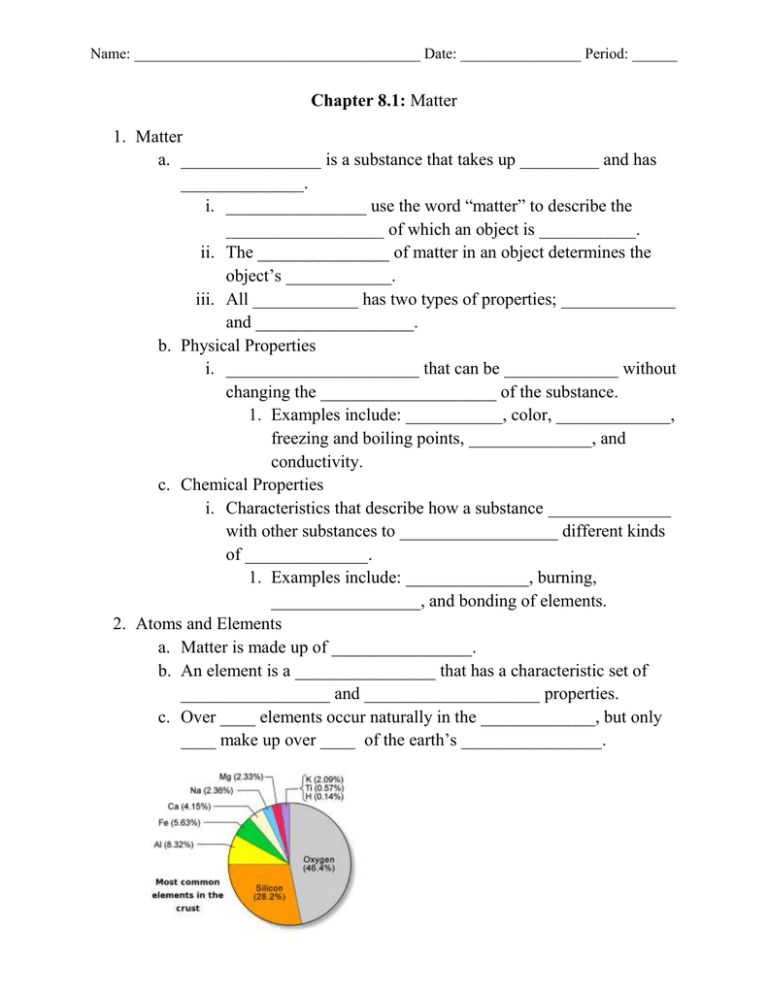Chapter 8.1
advertisement

Name: ______________________________________ Date: ________________ Period: ______ Chapter 8.1: Matter 1. Matter a. ________________ is a substance that takes up _________ and has ______________. i. ________________ use the word “matter” to describe the __________________ of which an object is ___________. ii. The _______________ of matter in an object determines the object’s ____________. iii. All ____________ has two types of properties; _____________ and __________________. b. Physical Properties i. ______________________ that can be _____________ without changing the ____________________ of the substance. 1. Examples include: ___________, color, _____________, freezing and boiling points, ______________, and conductivity. c. Chemical Properties i. Characteristics that describe how a substance ______________ with other substances to __________________ different kinds of ______________. 1. Examples include: ______________, burning, _________________, and bonding of elements. 2. Atoms and Elements a. Matter is made up of ________________. b. An element is a ________________ that has a characteristic set of _________________ and ____________________ properties. c. Over ____ elements occur naturally in the _____________, but only ____ make up over ____ of the earth’s ________________. Name: ______________________________________ Date: ________________ Period: ______ d. All elements are made up of ___________ i. Atoms are the _____________ unit of an ______________ and contain all the __________________ of that element. ii. Atoms of elements are __________________ for each element. iii. Elements can be ___________________ by their ___________. 3. Atomic Structure a. The _______________ table is a system for ____________________ elements. i. Elements in the same ____________ on the periodic table have similar _____________________ of their _________________ and therefore similar chemical __________________. b. _________________ particles make up the _____________ of atoms. c. The three main subatomic ______________ are _________________, _______________, and __________________. Properties of Subatomic Particles Particle Symbol Relative Charge Relative mass Actual Mass (g) (Proton = 1) Electron Proton Neutron d. The _____________ is a small region in the ____________ of an atom and ________________ the protons and neutrons of an atom. i. The nucleus is a _____________ mass in the center of an atom and contains the _______________ of the atoms ___________. e. The __________________ are moving around the a region of space _______________ of the nucleus known as an electron ___________. f. Atomic Number i. The atomic ______________ of an atom is ______________ to the number of ______________ in that atom and is ______________ to each element. ii. All __________ of any one element have the same __________ number. Name: ______________________________________ Date: ________________ Period: ______ iii. An _________________ neutral atom has the same number of ____________ and ________________ and therefore the atomic number equals both, the protons and electrons. g. Mass Number i. The _________ number of any __________ represents the _________ of the number of protons and neutrons in that atom. ii. The unit for atomic _________ is (_____) for atomic mass unit. iii. Protons and ______________ have an amu of about __, while _____________ have a mass of about __________ amu and is the reason why their mass is ________________ while calculating an ________________ atomic mass. 4. Isotopes a. ___________ of the same element that ___________ from each other in __________ number are called isotopes. i. ______________ have the ___________ number of protons and electrons, but a different number of __________________. 5. Classification of Matter a. Matter can be __________________ into three categories: ____________, ________________, and _______________. b. The _______________ in a solid are packed _____________ together in a fixed position and are ______ free to move very much. i. Solids have a definite ____________ and _______________. c. The particles in a _____________ are tightly packed together but they are __________ to move. i. Liquids have a definite ____________ but take the shape of their ____________________. d. The particles in a ________ are farther apart from each other and move _______________ and more freely than _________________. i. A gas does ________ have a definite volume or shape. 6. Thermal Energy and Matter a. When __________ is added to a ___________, the atoms break away from each other and begin to move _______________ until the solid material changes __________ and becomes a _______________. When ___________ heat is added, the atoms continue to pick up ____________ and _____________ and become a _________.





